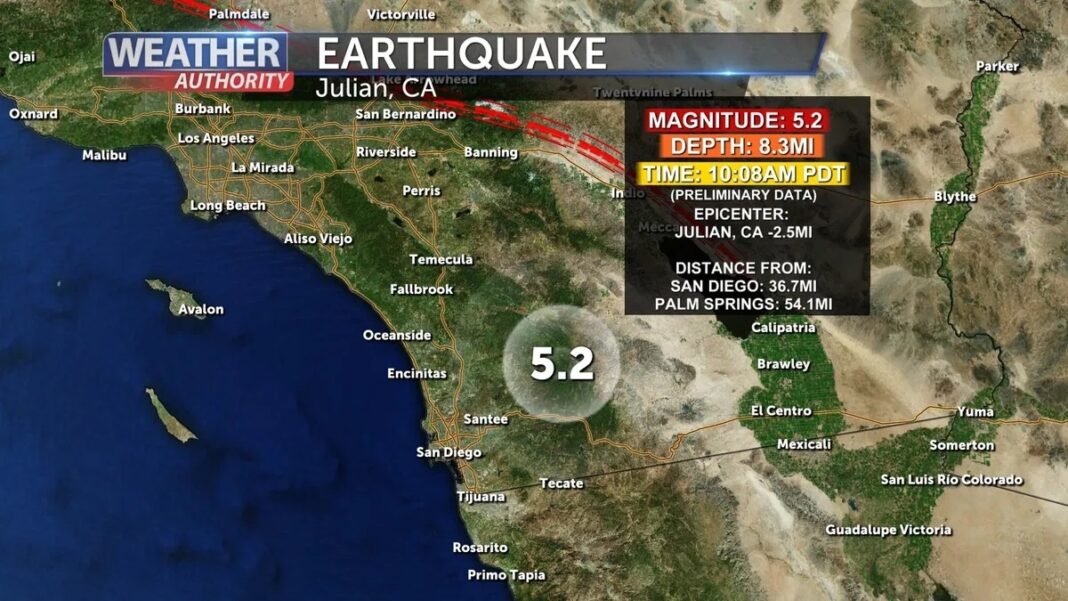A bunch of aftershocks hit eastern San Diego County on Monday. These smaller quakes came right after a big one shook the ground near Julian. The big quake had a 5.2 magnitude and struck around 10:08 a.m. But the shaking didn’t stop there. In the hours that followed, at least ten more quakes rolled through. These are called aftershocks. They are normal after a big earthquake. When aftershocks shake the ground, it means the ground needs time to settle. So it keeps moving in smaller bursts.
Aftershocks Hit Just Minutes After Main Quake
The first aftershocks came just two minutes after the big one. At 10:10 a.m., two quakes hit at the same time. Both were 2.9 in size. One minute later, another aftershock hit. That one was a 2.7. At 10:12 a.m., two more rolled through. One was a 2.6. The other was a stronger one — 3.5 near Borrego Springs. That’s east of Julian. Then at 10:13 a.m., a 3.0 aftershock struck 4 kilometers south of Julian. One minute later, another hit. When more aftershocks shake an area, like the 2.5 one in the same area, the shaking just kept coming.
Stronger Aftershock Hits Almost an Hour Later
At 11:23 a.m., another strong aftershock hit. This one was a 4.0. That’s big enough to feel. It rattled the same area near Julian. Later in the day, more shaking was recorded. A 2.6 aftershock hit at 12:34 p.m. Then, at 1:23 p.m., another 2.9 hit near Julian. Most of these aftershocks were between 1 and 5 kilometers south of town. Only the 3.5 near Borrego Springs was outside that zone. That’s a lot of shaking in just a few hours, and when aftershocks shake, it can be felt widely.
What Causes All These Aftershocks?
The U.S. Geological Survey says aftershocks are part of how the earth settles after a big quake. When the fault moves, the ground shifts. That big shake causes pressure. Aftershocks help release that pressure. When aftershocks shake, they can come fast at first. Then they slow down over time. Sometimes they keep coming for days. Sometimes for weeks or even longer. It depends on how big the first quake was. The bigger it is, the longer the aftershocks may last.
People Advised to Stay Safe in Case of More Shaking
Local officials are warning folks to stay safe. Aftershocks may keep coming. People should stay indoors if they can. Stay away from windows and shelves. If the shaking starts, drop down. Cover your head. Hold on tight until it stops. That’s the best way to stay safe. Don’t go outside during shaking. It’s better to stay where you are and protect yourself. The aftershocks shake buildings and can cause hazards, so it’s crucial to remain alert.
No Reports of Damage or Injuries So Far
Even with all that shaking, no one got hurt. The San Diego County Sheriff’s Office said there were no reports of injuries. Also, no big damage was reported. That’s good news. It means buildings held up and people were careful. Emergency crews are still watching the area in case anything changes. They will continue to monitor as aftershocks shake the region intermittently.
No Tsunami Warning Issued for the Coast
Some folks worry about tsunamis after earthquakes. But not this time. The National Weather Service said no tsunami was expected. The quake didn’t hit in the ocean. So the coast was safe. No danger from the sea this time.







